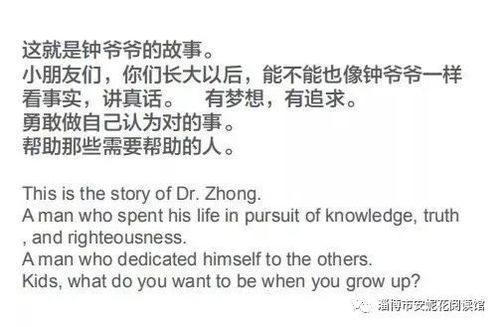What is the English translation for "small mouth, big eyes, big ears"?
An Exploration of "Small Mouth, Big Eyes, Big Ears" in English

In the realm of physical attributes, there are countless combinations and permutations that make each individual unique. Among these, the combination of "small mouth, big eyes, and big ears" stands out as a distinctive set of features that can captivate the imagination and spark curiosity. This article aims to delve into the English translations and cultural connotations of these attributes, offering a comprehensive understanding for our target audience.

First and foremost, let's tackle the literal translations. "Small mouth" in English can be expressed as "small lips" or "petite mouth," depending on the context and the specific attribute you wish to emphasize. The term "small lips" tends to focus on the thinness or compactness of the lips, while "petite mouth" conveys a sense of being small in size. Both terms capture the essence of having a mouth that is not prominent or oversized.

Moving on to "big eyes," the straightforward translation is "big eyes" or "large eyes." This phrase clearly communicates the attribute of having eyes that are larger than average, often associated with a sense of innocence, curiosity, or even expressiveness. Big eyes are often perceived as attractive and can significantly influence one's appearance.
Lastly, "big ears" translates to "large ears" in English. Similar to "big eyes," this phrase simply describes ears that are larger than the norm. Big ears can be a striking feature and, in some cultures, are even considered a sign of wisdom or good fortune.
However, translating these attributes goes beyond mere words. Each set of features carries its own cultural significance and symbolism. For instance, in many cultures, big eyes are often seen as a sign of youth, innocence, and beauty. They can make a person look more approachable and expressive, which is why they are often featured prominently in artwork and literature. In contrast, small mouths might be associated with delicacy, grace, and a refined sense of taste.
Big ears, on the other hand, can evoke a range of reactions. While some cultures view them as a sign of wisdom and intelligence, others might see them as less aesthetically pleasing. However, it's important to note that beauty is subjective, and what one person finds attractive may not necessarily align with societal norms or cultural expectations.
In addition to their cultural significance, these attributes can also play a role in personal identity and self-perception. For individuals who possess them, these features may shape their sense of self and how they interact with the world. They may even influence their career choices, relationships, and overall life experiences.
For example, someone with big eyes might find that they are often perceived as more expressive and empathetic, which could lead them to pursue careers in fields like acting, modeling, or psychology. On the other hand, someone with big ears might learn to embrace their uniqueness and use it as a source of strength and confidence.
It's also worth mentioning that these attributes can be influenced by genetics, environment, and even personal habits. For instance, the size and shape of one's eyes can change over time due to factors like aging, sun exposure, and lifestyle choices. Similarly, the size of one's ears can be affected by genetics, hormones, and even ear-related conditions.
In the realm of fashion and beauty, these attributes can also have an impact. Makeup artists and hairstylists often take into account the size and shape of a person's features when crafting a look. For instance, someone with big eyes might benefit from a subtle eye makeup look that emphasizes their natural beauty, while someone with small lips might opt for a bold lip color to create a more striking appearance.
Furthermore, these attributes can play a role in social dynamics. People with striking features like big eyes or big ears may find themselves the center of attention, whether they like it or not. They may receive compliments, comments, or even stares from others, which can affect their self-esteem and sense of belonging.
Despite their potential impact, it's important to remember that physical attributes are just one aspect of a person's identity. They should not be the sole basis for judgment or evaluation. Instead, we should focus on a person's character, personality, and abilities, which are far more meaningful and enduring than their appearance.
In conclusion, "small mouth, big eyes, and big ears" are a set of distinctive physical attributes that carry their own cultural significance and symbolism. While they may influence our perceptions and interactions with others, they should not be the sole focus of our attention. Instead, we should strive to appreciate and embrace the uniqueness of each individual, regardless of their appearance. By doing so, we can foster a more inclusive and compassionate society that values diversity and individuality.
Moreover, as we navigate the ever-evolving landscape of fashion, beauty, and self-expression, it's crucial to remember that true beauty comes from within. Our physical attributes are just one part of our complex and multifaceted selves. They may catch the eye, but it's our inner qualities that truly shine and resonate with others.
As we continue to explore and celebrate the diversity of human appearance, let us also strive to cultivate a deeper understanding and appreciation of the many facets that make each person unique. By doing so, we can build stronger connections, foster greater empathy, and create a world that values and embraces the inherent beauty in all of us.
In essence, "small mouth, big eyes, and big ears" are not just a set of physical attributes; they are a reminder of the infinite variety and beauty that exists in the world. Let us cherish and celebrate this diversity, and strive to see the inherent worth and value in every individual we encounter.
- 上一篇: 揭秘!青浦区邮编号码大全,快来查看吧!
- 下一篇: 唐国强的身高体重是多少?
-

-

-

-
 What is the English Term for Badminton?资讯攻略02-07
What is the English Term for Badminton?资讯攻略02-07 -

-
 What is the English Word for Abstract?资讯攻略12-06
What is the English Word for Abstract?资讯攻略12-06












